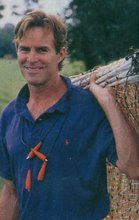Our journey to this these 64-acres we call Wonderland, next door to Poosey Conservation Area and the largest Amish settlement west of the Mississippi, has taken us through overlapping periods of row crop farming, purebred cattle business, management intensive grazing and a natural meat business.
We migrated from the center of conventional agriculture to the edge of alternative agriculture. When you start as green city kids that is a long row to hoe. Fortunately, we had many amazing teachers along the way and – the real blessing of being new to it all – we kept our minds open to the many possibilities available.
It’s always more fun on the edge (and the lead dog always gets the best view!) so, in the spirit of chronicling and showing off, but also with the sincere hope of inspiring your ride on the edge, I'll share some views and activities that led us to Wonderland.
 The purebred Gelbvieh herd and controlled grazing – 1980s & 90s.
The purebred Gelbvieh herd and controlled grazing – 1980s & 90s.With a 45-day calving period, management intensive grazing and no supplemental feeding, we developed an elite herd of females recognized by the Gelbvieh Association for outstanding reproductive performance. The Gelbvieh cattle were our bread and butter through the 80s.
 Grassfed meant organic in 1995
Grassfed meant organic in 1995
After travelling to New Zealand, first in 1987, then '91 and finally '95, we become fervent believers in the power of proper pasture management. To that end I organized the Green Hills Farm Project grazing group in 1988 and helped Jim Gerrish and Fred Martz start the popular University of Missouri Grazing School at Linneus.
During this period, I couldn't stop preaching the gospel according to grass and contributed to the Stockman/Grassfarmer frequently as well as a smattering of other magazines like the Country Journal above.
From pasture raised to direct marketing didn't seem like a big leap. We already had a unique, healthy product that was simple to sell. We knew the world was going to discover grass fed meats when Jo Robinson discovered them and produced her fabulous little book (below) and seminal website, www.eatwild.com.
 Schafer Farms steer and lambs on the cover of Pasture Perfect by Jo Robinson
Schafer Farms steer and lambs on the cover of Pasture Perfect by Jo Robinson
 Bush pigs that don't
Bush pigs that don't Free Ranger chick on border patrol - Prairie Schooner in background
Free Ranger chick on border patrol - Prairie Schooner in background
 Schooner as Shade Mobile in mid-summer between batches of chickens
Schooner as Shade Mobile in mid-summer between batches of chickens
To better utilize the forages, we added lambs in 1989 and began direct meat sales to consumers. Pastured chickens and pigs were added in 1993, doubling our direct marketed revenues every year for the next four years. Seeing the potential to support ourselves on our own farm, we left the 540-acre family farm and homesteaded our own 64-acres eight miles away.
 Putting the straw bales in
Putting the straw bales in
Having lived in a drafty, old, secondary farm house for 20 years, we opted for an efficient and environmentally friendlier alternative and built our Wonderland home. 1998-2000.
Those are the highlights of two decades of agricultural adventures. For an historical perspective of the evolution of the Featherman plucker check out "The Story of the Featherman."


1 comment:
Each step you described here deserves it's own blog post! :-) Looking forward to reading more.
Post a Comment